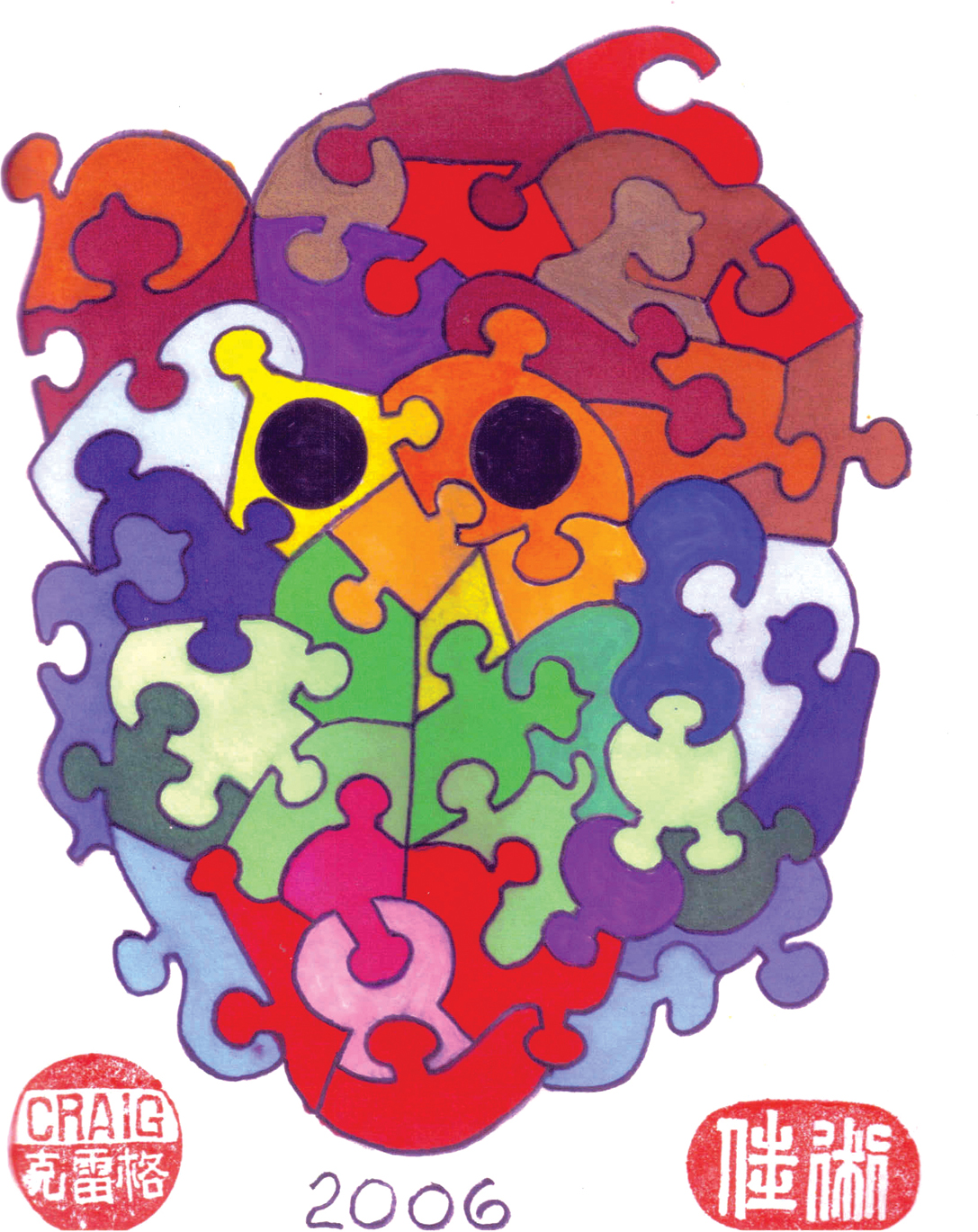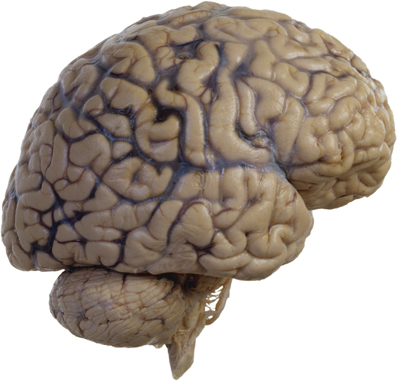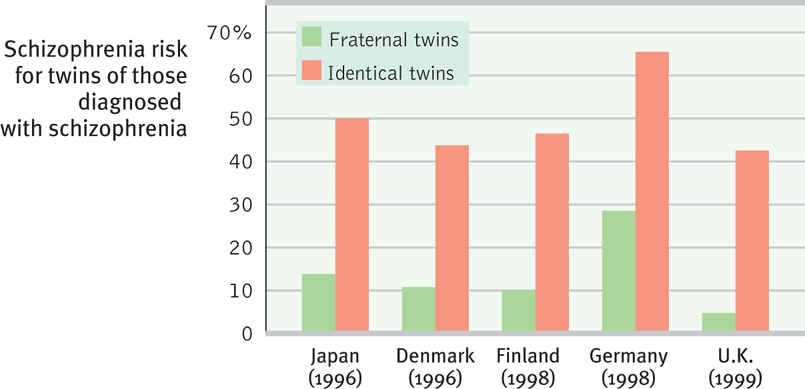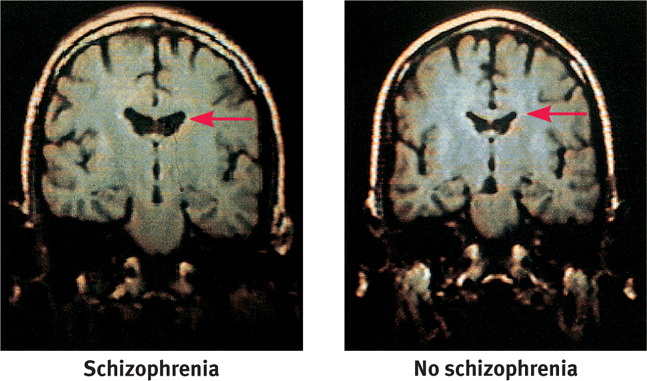Schizophrenia
 During their most severe periods, people with schizophrenia live in a private inner world, preoccupied with the strange ideas and images that haunt them. The word itself means “split” (schizo) “mind” (phrenia). But in this disorder, the mind is not split into multiple personalities. Rather, the mind has suffered a split from reality that shows itself in disturbed perceptions, disorganized thinking and speech, and diminished, inappropriate emotions and actions.
During their most severe periods, people with schizophrenia live in a private inner world, preoccupied with the strange ideas and images that haunt them. The word itself means “split” (schizo) “mind” (phrenia). But in this disorder, the mind is not split into multiple personalities. Rather, the mind has suffered a split from reality that shows itself in disturbed perceptions, disorganized thinking and speech, and diminished, inappropriate emotions and actions.
As you can imagine, these traits profoundly disrupt social relationships and make it difficult to hold a job. Given a supportive environment, some eventually recover to enjoy a normal life or to experience only occasional bouts of schizophrenia. Others remain socially withdrawn and isolated for much of their life.
Symptoms of Schizophrenia
13-17 What patterns of thinking, perceiving, and feeling characterize schizophrenia?
Schizophrenia patients with positive symptoms may have hallucinations or talk in disorganized and deluded ways. They may laugh or cry or lash out in rage at inappropriate times. Their symptoms are “positive” in the sense that inappropriate behaviors are present.
Those with negative symptoms may have toneless voices, expressionless faces, or mute and rigid bodies. Their symptoms are “negative” in the sense that actions or feelings are absent when you might expect them to be present.
Disorganized Speech

Imagine trying to communicate with Maxine, a young woman whose thoughts spill out in no logical order. Her biographer, Susan Sheehan (1982, p. 25), observed her saying aloud to no one in particular, “This morning, when I was at Hillside [Hospital], I was making a movie. I was surrounded by movie stars…. I’m Mary Poppins. Is this room painted blue to get me upset? My grandmother died four weeks after my eighteenth birthday.”
As this strange speech illustrates, the thinking of a person with schizophrenia is fragmented and often distorted by false beliefs called delusions. Maxine believed she was Mary Poppins. People with paranoid tendencies often believe they are being threatened or pursued.
Disorganized thinking may appear as word salad, jumbled ideas that make no sense even within sentences. One young man begged for “a little more allegro in the treatment,” and suggested that “liberationary movement with a view to the widening of the horizon” will “ergo extort some wit in lectures.”
Disturbed Perceptions
Delusions are false beliefs. Hallucinations are false perceptions. People with schizophrenia sometimes see, feel, taste, or smell things that exist only in their minds. Most often, however, the hallucinations are sounds, often voices making insulting remarks or giving orders. The voices may tell the person that she is bad or that she must burn herself with a cigarette lighter. Imagine your own reaction if a dream broke into your waking consciousness, making it hard to separate your experience from your imagination. Stuart Emmons described his experience:
When someone asks me to explain schizophrenia I tell them, you know how sometimes in your dreams you are in them yourself and some of them feel like real nightmares? My schizophrenia was like I was walking through a dream. But everything around me was real. At times, today’s world seems so boring and I wonder if I would like to step back into the schizophrenic dream, but then I remember all the scary and horrifying experiences (Emmons et al., 1997).
When the unreal seems real, the resulting perceptions are at best bizarre, at worst terrifying.
Diminished and Inappropriate Emotions and Actions
The expressed emotions of schizophrenia are often utterly inappropriate, split off from reality (Kring & Caponigro, 2010). Maxine laughed after recalling her grandmother’s death. On other occasions, she cried when others laughed, or became angry for no apparent reason. Others with schizophrenia lapse into an emotionless flat affect, a zombielike state of no apparent feeling. Many people with schizophrenia have difficulty reading other people’s facial emotions and states of mind (Green & Horan, 2010; Kohler et al., 2010).
398
Inappropriate motor behavior takes many forms. Some patients perform senseless, compulsive acts, such as continually rocking or rubbing an arm. Others may remain motionless for hours and then become agitated.
Onset and Development of Schizophrenia
13-18 How do chronic and acute schizophrenia differ?

Nearly 1 in 100 people develop schizophrenia, with an estimated 24 million worldwide suffering from this disorder (Abel et al., 2010; WHO, 2011). It typically strikes as young people are maturing into adulthood. It knows no national boundaries, and it affects both men and women. Men tend to be struck earlier, more severely, and slightly more often (Picchioni & Murray, 2007).
For some, schizophrenia appears suddenly, seemingly as a reaction to stress. For others, as was the case with Maxine, schizophrenia develops gradually, emerging from a long history of social inadequacy. This may help explain why people predisposed to schizophrenia often are found in the lower socioeconomic levels, or even homeless.
One rule holds true around the world (WHO, 1979): When schizophrenia is a slow-developing process (called chronic, or process, schizophrenia), recovery is doubtful. Social withdrawal, a negative symptom, is common among those with chronic schizophrenia. Men more often exhibit negative symptoms and chronic schizophrenia (Räsänen et al., 2000). Recovery is much more likely when a well-adjusted person develops schizophrenia rapidly following some sort of stress (called acute, or reactive, schizophrenia).
Understanding Schizophrenia
13-19 What do we know about the brain chemistry, functions, and structures associated with schizophrenia, and what have we learned about prenatal risk factors?
Schizophrenia is a dreaded psychological disorder. It is also one of the most heavily researched. Most of the new research studies link it with abnormal brain tissue and activity, and with genetic predispositions. Schizophrenia is a disease of the brain exhibited in symptoms of the mind.
Brain Abnormalities
What sorts of brain abnormalities might explain schizophrenia? Biochemical imbalances? Abnormal brain activity? Problems with brain structures or functions? Researchers are taking a close look at all of these.
BRAIN CHEMISTRY Scientists have long known that strange behavior can have strange chemical causes. Have you ever heard the phrase “mad as a hatter”? The saying dates back to the behavior of British hatmakers whose brains were slowly poisoned as they used their tongue and lips to moisten the brims of mercury-laden felt hats (Smith, 1983). Could the hallucinations and other symptoms of schizophrenia have a similar biochemical key?
One possible answer emerged when researchers examined schizophrenia patients’ brains after death. They found an excess number of dopamine receptors (Seeman et al., 1993; Wong et al., 1986). What could this mean? Perhaps a high level of dopamine could intensify brain signals, creating positive symptoms such as hallucinations and paranoia. Sure enough, other evidence confirmed this idea. Drugs that block dopamine receptors often lessen the positive symptoms of schizophrenia. Drugs that increase dopamine levels, such as amphetamines and cocaine, sometimes intensify them (Seeman, 2007; Swerdlow & Koob, 1987). But there’s more to schizophrenia than abnormal brain chemistry.
ABNORMAL BRAIN ACTIVITY AND ANATOMY Brain scans show that abnormal brain activity and brain structures accompany schizophrenia. Some patients have abnormally low activity in the brain’s frontal lobes, which are critical for reasoning, planning, and problem solving (Morey et al., 2005; Pettegrew et al., 1993; Resnick, 1992).
One study took PET scans of brain activity while people were hallucinating (Silbersweig et al., 1995). When patients heard a voice or saw something, their brain became vigorously active in several core regions. One was the thalamus, the structure that filters incoming sensory signals and transmits them to the brain’s cortex. Another PET scan study of people with paranoia (who may have delusions of persecution) found increased activity in the amygdala, a fear-processing center (Epstein et al., 1998).
In schizophrenia, areas of the brain become enlarged and fill with fluid; cerebral tissue also shrinks (Goldman et al., 2009; Wright et al., 2000). “People with schizophrenia are losing brain tissue at a more rapid rate than healthy people,” noted one researcher (Andreasen, 2008). The greater the shrinkage, the more severe the thought disorder (Collinson et al., 2003; Nelson et al., 1998; Shenton, 1992). Some studies have even found brain abnormalities in people who would later develop this disorder (Boos et al., 2007; Job et al., 2006).
The bottom line of various studies is clear. Schizophrenia involves not one isolated brain abnormality but problems with several brain regions and their interconnections (Andreasen, 1997, 2001).
Prenatal Environment and Risk
What causes the brain abnormalities that are found in people with schizophrenia? Some researchers blame low birth weight or lack of oxygen during delivery (Buka et al., 1999; Zornberg et al., 2000). Famine may also increase risks. People conceived during the peak of World War II’s Dutch famine developed schizophrenia at twice the normal rate. Those conceived during the famine of 1959 to 1961 in eastern China also displayed this doubled rate (St. Clair et al., 2005; Susser et al., 1996).
399
Let’s consider another possible culprit. Might a midpregnancy viral infection impair fetal brain development (Patterson, 2007)? To test this fetal-virus idea, scientists have asked these questions:
- Are people at increased risk of schizophrenia if, during the middle of their fetal development, their country experienced a flu epidemic? The repeated answer is Yes (Mednick et al., 1994; Murray et al., 1992; Wright et al., 1995).
- Are people who are born in densely populated areas, where viral diseases spread more readily, at greater risk for schizophrenia? The answer, confirmed in a study of 1.75 million Danes, is Yes (Jablensky, 1999; Mortensen, 1999).
- Are people born during the winter and spring months—after the fall-winter flu season—also at increased risk? The answer is again Yes, and the risk increases from 5 to 8 percent (Torrey et al., 1997, 2002).
- In the Southern Hemisphere, where the seasons are the reverse of the Northern Hemisphere, are the months of above-average schizophrenia births similarly reversed? Again, the answer is Yes. In Australia, people born between August and October are at greater risk. But there is an exception. For people born in the Northern Hemisphere, who later moved to Australia, the risk is greater if they were born between January and March (McGrath et al., 1995, 1999).
- Are mothers who report being sick with influenza during pregnancy more likely to bear children who develop schizophrenia? In one study of nearly 8000 women, the answer was Yes. The schizophrenia risk increased from the customary 1 percent to about 2 percent. But that increase applied only to mothers who were infected during their second trimester (Brown et al., 2000).
- Does blood drawn from pregnant women whose offspring develop schizophrenia suggest a viral infection? In a huge California study, which collected blood samples from some 20,000 pregnant women during the 1950s and 1960s, the answer was again Yes. Some children born of those pregnancies were later diagnosed with schizophrenia. Antibodies in the blood samples indicated whether the women had been exposed to influenza. When the exposure took place during the first half of the pregnancy, the child’s risk of developing schizophrenia tripled. Exposure to flu during the second half of the pregnancy produced no such increase (Brown et al., 2004).
Taken together, these converging lines of evidence suggest a key to the schizophrenia puzzle: Prenatal viral infections can contribute to the development of schizophrenia. This finding strengthens the U.S. government recommendation that “women who expect to be more than three months pregnant during the flu season” should have a flu shot (CDC, 2013).
Genetics and Risk
13-20 Does research indicate a genetic contribution to schizophrenia?
Prenatal viruses increase the odds that a child will develop schizophrenia. But many women get the flu during their second trimester of pregnancy, and only 2 percent of their children develop schizophrenia. Why does prenatal exposure to the flu virus put some children at risk but not others? Could the answer be that some people are more vulnerable because they have inherited a predisposition to this disorder? The evidence indicates the answer is Yes. For most people, the odds of being diagnosed with schizophrenia are nearly 1 in 100. For those who have a sibling or parent with schizophrenia, the odds increase to 1 in 10. And if the affected sibling is an identical twin, the odds are close to 5 in 10 (FIGURE 13.13). Those odds are unchanged even if the twins are raised apart (Plomin et al., 1997). (Only a dozen or so of these cases are on record.)

But wait! Identical twins also share a prenatal environment. So it is possible that shared germs as well as shared genes produce identical twin similarities. And there is some evidence to support this idea.
About two-thirds of identical twins also share a placenta and the blood it supplies. The other sets of identical twins have two separate placentas. Sharing a placenta raises the odds of later sharing a schizophrenia diagnosis. If identical twins had separate placentas, the chances are 1 in 10. If they shared a placenta, the co-twin’s chances of having the disorder are 6 in 10 (Davis et al., 1995a,b; Phelps et al., 1997). A likely explanation: Identical twins who share a placenta are more likely to share the same prenatal viruses.
400
How, then, can we untangle the genetic influences from the environmental influences on this disorder? Adoption studies offer some clues. Children adopted by someone who develops schizophrenia seldom “catch” the disorder. Rather, adopted children have a higher risk of developing schizophrenia if one of their biological parents has this disorder. So, adoption studies confirm that the genetic link is real (Gottesman, 1991).
The search is on for specific genes that, in some combination, might lead to schizophrenia-inducing brain abnormalities (Levinson et al., 2011; Mitchell & Porteous, 2011; Ripke et al., 2011; Vacic et al., 2011). (It is not our genes but our brains that directly control our behavior.) Some of these genes influence the activity of dopamine and other brain neurotransmitters. Others affect the production of myelin, a fatty substance that coats the axons of nerve cells and lets impulses travel at high speed through neural networks.

Although genes matter, the genetic formula is not as straightforward as the inheritance of eye color. Genome studies of thousands of individuals with and without schizophrenia indicate that schizophrenia is influenced by many genes, each with very small effects (International Schizophrenia Consortium, 2009; Pogue-Geile & Yokley, 2010). Recall again that epigenetic (literally “in addition to genetic”) factors influence gene expression. Like hot water activating a tea bag, environmental factors such as viral infections, nutritional deprivation, and maternal stress can “turn on” the genes that put some of us at higher risk for this disorder. Identical twins’ differing histories in the womb and beyond explain why only one may show differing gene expressions (Walker et al., 2010). As we have seen in so many different contexts, nature and nurture interact. Neither hand claps alone.
* * *
Most of us can relate more easily to the ups and downs of mood disorders than to the strange thoughts, perceptions, and behaviors of schizophrenia. Sometimes our thoughts do jump around, but we do not talk nonsensically. Occasionally, we feel unjustly suspicious of someone, but we do not believe the world is plotting against us. Often, our perceptions err, but rarely do we see or hear things that are not there. We have felt regret after laughing at someone’s misfortune, but we rarely giggle in response to bad news. At times we just want to be alone, but we do not live in social isolation. However, millions of people around the world do talk strangely, suffer delusions, hear nonexistent voices, see things that are not there, laugh or cry at inappropriate times, or withdraw into private imaginary worlds. The quest to solve the cruel puzzle of schizophrenia therefore continues, more vigorously than ever. 
RETRIEVE + REMEMBER
Question 13.13
A person with schizophrenia who has __________ (positive/negative) symptoms may have an expressionless face and toneless voice.
negative
Question 13.14
What factors contribute to the onset and development of schizophrenia?
Biological factors include abnormalities in brain structure and function, prenatal exposure to a maternal virus, and genetic factors. However, schizophrenia is more likely to develop given a high-risk environment.